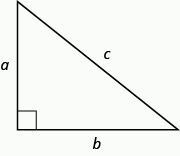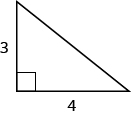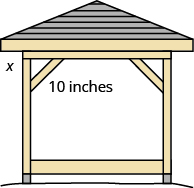Using the Pythagorean Theorem to Solve Problems
Learning Outcomes
- Use the Pythagorean theorem to find the unknown side length of a right triangle
 The Pythagorean theorem tells how the lengths of the three sides of a right triangle relate to each other. It states that in any right triangle, the sum of the squares of the two legs equals the square of the hypotenuse.
The Pythagorean theorem tells how the lengths of the three sides of a right triangle relate to each other. It states that in any right triangle, the sum of the squares of the two legs equals the square of the hypotenuse.
The Pythagorean Theorem
In any right triangle [latex]\Delta ABC[/latex],[latex]{a}^{2}+{b}^{2}={c}^{2}[/latex]
where [latex]c[/latex] is the length of the hypotenuse [latex]a[/latex] and [latex]b[/latex] are the lengths of the legs.
[latex]\text{If }m={n}^{2},\text{ then }\sqrt{m}=n\text{ for }n\ge 0[/latex]
For example, we found that [latex]\sqrt{25}[/latex] is [latex]5[/latex] because [latex]{5}^{2}=25[/latex]. We will use this definition of square roots to solve for the length of a side in a right triangle.example
Use the Pythagorean theorem to find the length of the hypotenuse. Solution
Solution
| Step 1. Read the problem. | |
| Step 2. Identify what you are looking for. | the length of the hypotenuse of the triangle |
| Step 3. Name. Choose a variable to represent it. | Let [latex]c=\text{the length of the hypotenuse}[/latex]
 |
| Step 4. Translate. Write the appropriate formula. Substitute. | [latex]{a}^{2}+{b}^{2}={c}^{2}[/latex] [latex]{3}^{2}+{4}^{2}={c}^{2}[/latex] |
| Step 5. Solve the equation. | [latex]9+16={c}^{2}[/latex] [latex-display]25={c}^{2}[/latex-display] [latex-display]\sqrt{25}={c}[/latex-display] [latex]5=c[/latex] |
| Step 6. Check: | [latex]{3}^{2}+{4}^{2}=\color{red}{{5}^{2}}[/latex] [latex-display]9+16\stackrel{?}{=}25[/latex-display] [latex]25+25\checkmark[/latex] |
| Step 7. Answer the question. | The length of the hypotenuse is [latex]5[/latex]. |
try it
[ohm_question]146913[/ohm_question]example
Use the Pythagorean theorem to find the length of the longer leg.
Answer: Solution
| Step 1. Read the problem. | |
| Step 2. Identify what you are looking for. | The length of the leg of the triangle |
| Step 3. Name. Choose a variable to represent it. | Let [latex]b=\text{the leg of the triangle}[/latex]
Label side b
 |
| Step 4. Translate. Write the appropriate formula. Substitute. | [latex]{a}^{2}+{b}^{2}={c}^{2}[/latex] [latex]{5}^{2}+{b}^{2}={13}^{2}[/latex] |
| Step 5. Solve the equation. Isolate the variable term. Use the definition of the square root. Simplify. | [latex]25+{b}^{2}=169[/latex] [latex-display]{b}^{2}=144[/latex-display] [latex-display]{b}=\sqrt{144}[/latex-display] [latex]b=12[/latex] |
| Step 6. Check: [latex-display]{5}^{2}+\color{red}{12}^{2}\stackrel{?}{=}{13}^{2}[/latex-display] [latex-display]25+144\stackrel{?}{=}169[/latex-display] [latex]169=169\checkmark[/latex] | |
| Step 7. Answer the question. | The length of the leg is [latex]12[/latex]. |
try it
[ohm_question]146914[/ohm_question]example
Kelvin is building a gazebo and wants to brace each corner by placing a [latex]\text{10-inch}[/latex] wooden bracket diagonally as shown. How far below the corner should he fasten the bracket if he wants the distances from the corner to each end of the bracket to be equal? Approximate to the nearest tenth of an inch.
Answer: Solution
| Step 1. Read the problem. | |
| Step 2. Identify what you are looking for. | the distance from the corner that the bracket should be attached |
| Step 3. Name. Choose a variable to represent it. | Let x = the distance from the corner
 |
| Step 4. Translate. Write the appropriate formula. Substitute. | [latex]{a}^{2}+{b}^{2}={c}^{2}[/latex] [latex]{x}^{2}+{x}^{2}={10}^{2}[/latex] |
| Step 5. Solve the equation. Isolate the variable. Use the definition of the square root. Simplify. Approximate to the nearest tenth. | [latex]2x^2=100[/latex] [latex-display]x^2=50[/latex-display] [latex-display]x=\sqrt{50}[/latex-display] [latex-display]b\approx{7.1}[/latex-display] |
| Step 6. Check: [latex-display]{a}^{2}+{b}^{2}={c}^{2}[/latex-display] [latex-display](\color{red}{7.1})^2+(\color{red}{7.1})^{2}\stackrel{\text{?}}{\approx}{10}^{2}[/latex-display] [latex-display]50.41+50.41=100.82\approx{100}\quad\checkmark[/latex-display] Yes. | |
| Step 7. Answer the question. | Kelvin should fasten each piece of wood approximately [latex]7.1in[/latex] from the corner. |
try it
[ohm_question]146916[/ohm_question] [ohm_question]146918[/ohm_question]Contribute!
Did you have an idea for improving this content? We’d love your input.
Licenses & Attributions
CC licensed content, Original
- Question ID 146918, 146916, 146914, 146913. Authored by: Lumen Learning. License: CC BY: Attribution.
CC licensed content, Shared previously
- Solve Applications Using the Pythagorean Theorem (c only). Authored by: James Sousa (mathispower4u.com). License: CC BY: Attribution.
CC licensed content, Specific attribution
- Prealgebra. Provided by: OpenStax License: CC BY: Attribution. License terms: Download for free at http://cnx.org/contents/[email protected].
